Manual de uso EnviraStation DWS-320 Estación meteorológica
¿Necesita un manual para su EnviraStation DWS-320 Estación meteorológica? A continuación puedes ver y descargar el manual en PDF gratis en español. Este producto actualmente tiene 5 preguntas frecuentes, 0 comentarios y tiene 0 votos. Si este no es el manual que desea, , contáctenos.
¿Su producto tiene algún defecto y el manual no ofrece ninguna solución? Vaya a Repair Café para solicitar un servicio de reparación gratuito.
Manual de uso
Loading…

Loading…
Puntuación
Dé su opinión de la EnviraStation DWS-320 Estación meteorológica calificando el producto. ¿Quiere compartir su experiencia con este producto o hacer una pregunta? Deje un comentario en la parte inferior de la página.Más sobre este manual
Entendemos que es bueno tener un manual en papel para tus EnviraStation DWS-320 Estación meteorológica. Siempre puedes descargar el manual desde nuestro sitio web e imprimirlo tú mismo. Si deseas tener un manual original te recomendamos contactar con EnviraStation. Es posible que puedan proporcionar un manual original. ¿Estás buscando el manual de tu EnviraStation DWS-320 Estación meteorológica en otro idioma? Elija su idioma preferido en nuestra página de inicio y busque el número de modelo para ver si lo tenemos disponible.
Especificaciones
| Marca | EnviraStation |
| Modelo | DWS-320 |
| Categoría | Estaciónes meteorológicas |
| Tipo de archivo | |
| Tamaño del archivo | 0.52 MB |
Todos los manuales para EnviraStation Estaciónes meteorológicas
Más manuales de Estaciónes meteorológicas
Preguntas frecuentes sobre EnviraStation DWS-320 Estación meteorológica
Nuestro equipo de atención al cliente busca información útil sobre los productos y responde a las preguntas frecuentes. Si encuentra inexactitudes en las preguntas frecuentes, indíquenoslo usando nuestro formulario de contacto.
La estación meteorológica predijo que llovería, pero esto no sucedió. ¿Por qué? Verificado
La predicción de la estación meteorológica se basa en la presión del aire. En general, la baja presión significa mal tiempo y la alta presión significa buen tiempo. Es posible que el patrón climático se desarrolle de manera diferente de lo que predice la presión del aire.
Ha sido de gran ayuda (1404) Leer más¿Cuál es la mejor ubicación para una estación meteorológica y sus sensores? Verificado
La propia estación meteorológica debe estar en el interior y mantenerse alejada de las fuentes de calor como la cocina, las ventanas o los electrodomésticos. Un sensor de temperatura exterior separado necesita ser colocado en la sombra y al menos a 1,25 m sobre el suelo. Un sensor de lluvia debe colocarse en una zona descubierta en la que siempre pueda recoger la lluvia. Un sensor de viento también debe instalarse en una zona abierta, sin que haya obstáculos que influyan en el viento.
Ha sido de gran ayuda (334) Leer másMi estación meteorológica incluye un pluviómetro. ¿También sirve para medir la cantidad de nieve que cae? Verificado
Algunos pluviómetros están equipados con un elemento calefactor, que hace que la nieve se derrita y se pueda medir su nivel. Sin el elemento calefactor, el pluviómetro se atascará sin que se pueda realizar ninguna medición.
Ha sido de gran ayuda (235) Leer másLa pila de mi dispositivo está oxidada. ¿Puedo seguir usándolo con seguridad? Verificado
Sí, todavía puede usar el dispositivo con seguridad. En primer lugar, retire la pila oxidada. Nunca la toque con sus manos desnudas al hacerlo. A continuación, limpie el compartimento de la pila con un bastoncillo de algodón mojado en vinagre o zumo de limón. Déjelo secar e inserte nuevas pilas.
Ha sido de gran ayuda (234) Leer más¿Puedo dejar una batería reemplazable en un dispositivo durante mucho tiempo? Verificado
Las baterías reemplazables pueden permanecer en un dispositivo durante mucho tiempo si el dispositivo está en uso. Cuando un dispositivo se almacena durante un tiempo prolongado, es recomendable retirar las baterías para evitar la oxidación.
Ha sido de gran ayuda (234) Leer más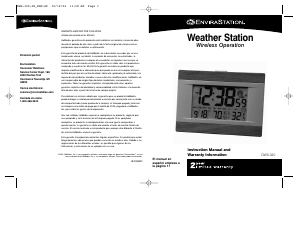


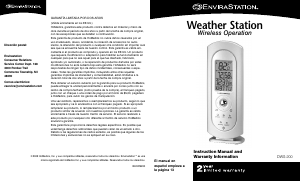
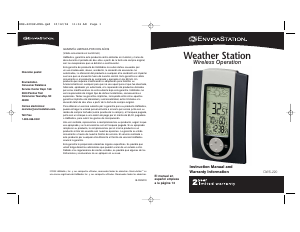
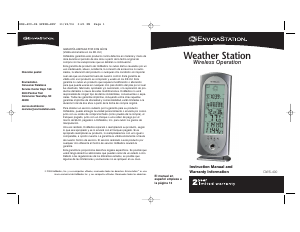

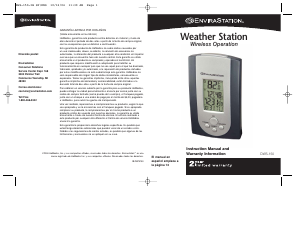


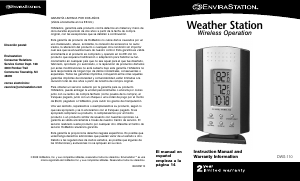
Únase a la conversación sobre este producto
Aquí puedes compartir lo que piensas sobre EnviraStation DWS-320 Estación meteorológica. Si tiene alguna pregunta, primero lea atentamente el manual. Puede solicitar un manual utilizando nuestro formulario de contacto.